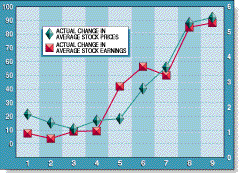One of Benjamin Graham's investment classics, The Intelligent Investor, has a chapter in which he discusses a comparison of the change in average stock earnings and the change in average stock prices. Intrigued, I decided to graph and calculate a linear correlation coefficient for the actual level in average stock earnings for the Standard & Poor's 500 versus the actual level in average stock prices for the S&P 500 in five-year intervals from 1930 to 1970, as reported by Graham.
TRADING TECHNIQUES
Predict The Market With Earnings Per Share
by Randall J. Covill
Take a look at the relationship between changes in earnings per share for each year and the performance of the market for the following year. Is there a correlation?
My results can be seen in Figure 1; the linear correlation coefficient is 92.78%. From this, I inferred that changes in average earnings per share over five years might be a good predictor of average changes in stock prices over the next five years. Percent changes in average S&P 500 earnings per share and percent changes in average S&P 500 price per share are not highly correlated, with a correlation coefficient of -4.6%. However, percent changes in average S&P 500 price per share in the current five-year period and percent changes in average S&P 500 earnings per share in the next five-year period are highly correlated, with a correlation coefficient of 78.33%.
This observation leads to the following formula: If x = the percent change in average earnings for the current five-year period and y = the percent change in average price per share in the subsequent five-year period, then y = (0.6144)(x) + 12.1919. This suggests that percent changes in average earnings per share can be used to indicate future changes in large stock prices at least some of the time and a successful trading system can be developed based on this relationship.

FIGURE 1: AVERAGE STOCK EARNINGS AND AVERAGE STOCK PRICES, 1930-70. Here is the actual level in average stock earnings and in average stock prices from 1930 to 1970 in five-year intervals for S&P 500 stocks.
The low correlation for the test period 1982-97, between percent changes in average earnings per share in the current period and percent changes in average prices per share in the subsequent period for the DJIA, suggests that some assumptions of the trading system are less valid today than they may have been in earlier markets.